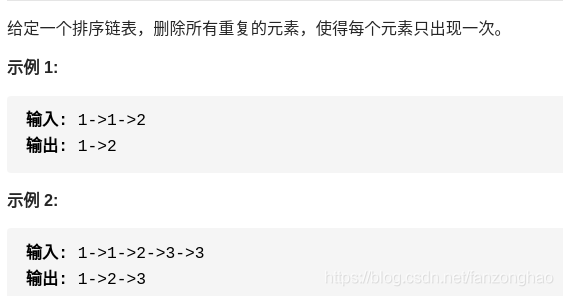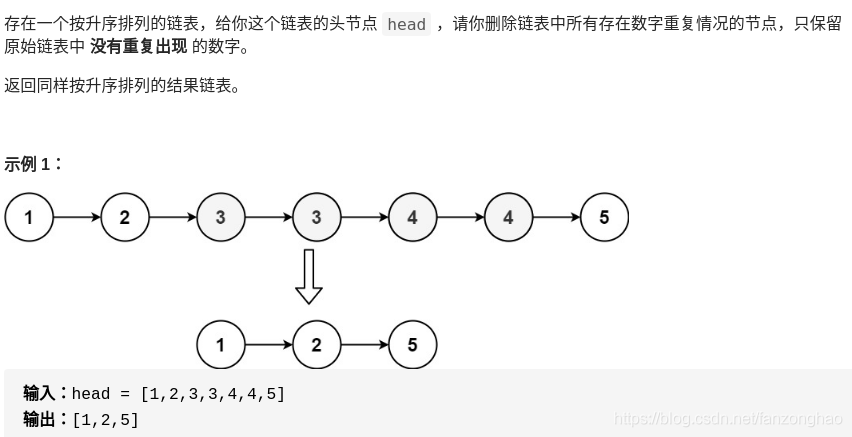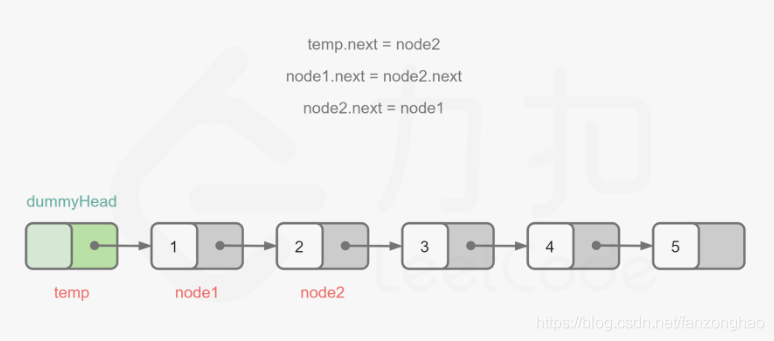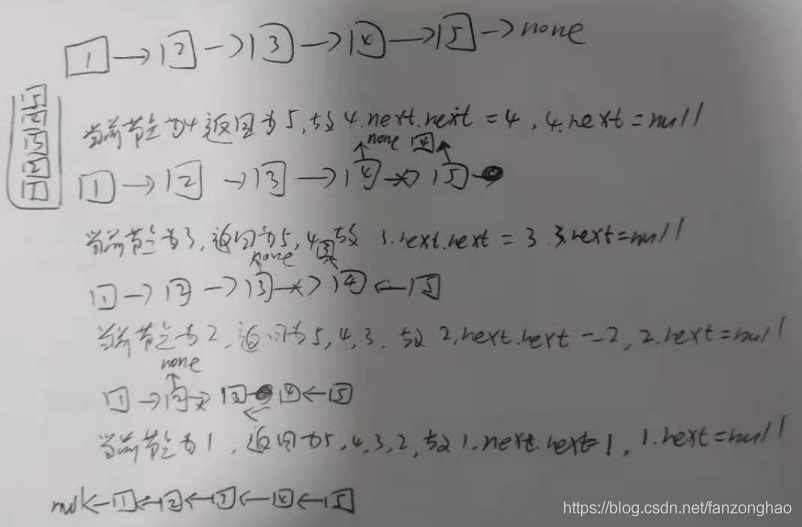主要常见下面几个知识点:?

1-1.请编写一个函数,使其可以删除某个链表中给定的(非末尾)节点,你将只被给定要求被删除的节点。

python:
# Definition for singly-linked list.
# class ListNode:
# def __init__(self, x):
# self.val = x
# self.next = None
class Solution:
def deleteNode(self, node):
"""
:type node: ListNode
:rtype: void Do not return anything, modify node in-place instead.
"""
node.val = node.next.val
node.next = node.next.next
c++实现:
/**
* Definition for singly-linked list.
* struct ListNode {
* int val;
* ListNode *next;
* ListNode(int x) : val(x), next(NULL) {}
* };
*/
class Solution {
public:
void deleteNode(ListNode* node) {
node->val = node->next->val;
node->next = node->next->next;
}
};
1-2.删除排序链表中的重复元素

通过将结点的值与它之后的结点进行比较来确定它是否为重复结点。如果它是重复的,我们更改当前结点的 next 指针,以便它跳过下一个结点并直接指向下一个结点之后的结点。如果不是重复的,则节点进行下移。
# Definition for singly-linked list.
# class ListNode:
# def __init__(self, x):
# self.val = x
# self.next = None
class Solution:
def deleteDuplicates(self, head: ListNode) -> ListNode:
node = head
while node and node.next:
if node.val == node.next.val:
node.next = node.next.next
else:
node = node.next
return head
c++实现:
/**
* Definition for singly-linked list.
* struct ListNode {
* int val;
* ListNode *next;
* ListNode() : val(0), next(nullptr) {}
* ListNode(int x) : val(x), next(nullptr) {}
* ListNode(int x, ListNode *next) : val(x), next(next) {}
* };
*/
class Solution {
public:
ListNode* new_node;
Solution(){};
Solution(const Solution& sol){
this->new_node = new ListNode(0, NULL);
this->new_node = sol.new_node;
}//深拷贝 堆区开辟空间重新赋值 解决释放内存的问题
ListNode* deleteDuplicates(ListNode* head) {
this->new_node = head;
while(this->new_node && this->new_node->next){
if(this->new_node->val == this->new_node->next->val){
this->new_node->next = this->new_node->next->next;
}
else{
this->new_node = this->new_node->next;
}
}
return head;
}
virtual ~Solution(){
if(this->new_node !=NULL){
this->new_node = NULL;
}
}
};
1-3.删除排序链表中的重复元素 II

思路:通过while循环一直去掉重复的元素
python:
# Definition for singly-linked list.
# class ListNode:
# def __init__(self, val=0, next=None):
# self.val = val
# self.next = next
class Solution:
def deleteDuplicates(self, head: ListNode) -> ListNode:
dummy_head = ListNode(0, head)
cur = dummy_head
while cur.next and cur.next.next:
if cur.next.val == cur.next.next.val:
x = cur.next.val
while cur.next and cur.next.val == x:
cur.next = cur.next.next
else:
cur = cur.next
return dummy_head.next
c++实现:?
/**
* Definition for singly-linked list.
* struct ListNode {
* int val;
* ListNode *next;
* ListNode() : val(0), next(nullptr) {}
* ListNode(int x) : val(x), next(nullptr) {}
* ListNode(int x, ListNode *next) : val(x), next(next) {}
* };
*/
class Solution {
public:
ListNode* dummy_head;
ListNode* cur_node;
Solution(){};
Solution(const Solution& sol){
dummy_head = sol.dummy_head;
cur_node = sol.cur_node;
}
ListNode* deleteDuplicates(ListNode* head) {
dummy_head = new ListNode(0, head);
cur_node = dummy_head;
while(cur_node->next && cur_node->next->next){
if(cur_node->next->val == cur_node->next->next->val){
int x = cur_node->next->val;
while(cur_node->next && cur_node->next->val == x){
cur_node->next = cur_node->next->next;
}
}
else{
cur_node = cur_node->next;
}
}
return dummy_head->next;
}
virtual ~Solution(){
if(dummy_head != NULL){
delete dummy_head;
dummy_head = NULL;
}
if(cur_node != NULL){
cur_node = NULL;
}
}
};
1-4.删除链表的倒数第N个节点

思路:找到链表长度,通过在头结点补充一个节点找到要删除的节点的上一个节点,然后在进行删除
方法1:循环
# Definition for singly-linked list.
# class ListNode:
# def __init__(self, val=0, next=None):
# self.val = val
# self.next = next
class Solution:
def removeNthFromEnd(self, head: ListNode, n: int) -> ListNode:
length = 0
node = head
#获取链表长度
while node:
length+=1
node= node.next
# print(length)
curr_length = 0
new_head = ListNode(0)
new_head.next = head
node2=new_head
stop_length = length - n
#循环走到要删除节点的前一个节点
while stop_length:
stop_length-=1
node2 = node2.next
#跳过要删除的节点即可
node2.next = node2.next.next
return new_head.next
方法2:递归
# Definition for singly-linked list.
# class ListNode:
# def __init__(self, val=0, next=None):
# self.val = val
# self.next = next
class Solution:
def __init__(self):
self.count = 0
def removeNthFromEnd(self, head: ListNode, n: int) -> ListNode:
if not head:
return head
head.next = self.removeNthFromEnd(head.next, n) # 递归调用
self.count += 1 # 回溯时进行节点计数
return head.next if self.count == n else head
方法3:双指针
fist 指针与second指针相隔n,这样first跑到尾部,second的下一个节点就是倒数第n个

# Definition for singly-linked list.
# class ListNode:
# def __init__(self, val=0, next=None):
# self.val = val
# self.next = next
class Solution:
# def __init__(self):
# self.count = 0
def removeNthFromEnd(self, head: ListNode, n: int) -> ListNode:
new_head = ListNode(0)
new_head.next = head
first = head
second = new_head
for i in range(n):
first = first.next
while first:
first = first.next
second = second.next
second.next = second.next.next
return new_head.next
c++实现:?
/**
* Definition for singly-linked list.
* struct ListNode {
* int val;
* ListNode *next;
* ListNode() : val(0), next(nullptr) {}
* ListNode(int x) : val(x), next(nullptr) {}
* ListNode(int x, ListNode *next) : val(x), next(next) {}
* };
*/
class Solution {
public:
ListNode* removeNthFromEnd(ListNode* head, int n) {
ListNode* new_head = new ListNode(0);
new_head ->next = head;
ListNode* first = head;
ListNode* second = new_head;
for(int i=0;i<n;i++){
first = first->next;
}
while(first){
first = first->next;
second = second->next;
}
second->next = second->next->next;
return new_head->next;
}
};
1-5. 删除链表的节点

思路:双指针
# Definition for singly-linked list.
# class ListNode:
# def __init__(self, x):
# self.val = x
# self.next = None
class Solution:
def deleteNode(self, head: ListNode, val: int) -> ListNode:
if head is None:
return head
new_head = ListNode(0)
new_head.next = head
pre = new_head
cur = head
while cur.val != val:
pre = cur
cur = cur.next
pre.next = cur.next
return new_head.next
c++实现:
/**
* Definition for singly-linked list.
* struct ListNode {
* int val;
* ListNode *next;
* ListNode(int x) : val(x), next(NULL) {}
* };
*/
class Solution {
public:
ListNode* deleteNode(ListNode* head, int val) {
if(head == NULL){
return NULL;
}
ListNode* new_head = new ListNode(0);
new_head->next = head;
ListNode* pre = new_head;
ListNode* cur = head;
while(cur->val != val){
pre = cur;
cur = cur->next;
}
pre->next = cur->next;
return new_head->next;
}
};
1-6.两两交换链表中的节点

思路:迭代法

python代码:?
# Definition for singly-linked list.
# class ListNode:
# def __init__(self, val=0, next=None):
# self.val = val
# self.next = next
class Solution:
def swapPairs(self, head: ListNode) -> ListNode:
new_head = ListNode(0)
new_head.next = head
temp = new_head
while temp.next and temp.next.next:
node1 = temp.next
node2 = temp.next.next
temp.next = node2
node1.next = node2.next
node2.next = node1
temp = node1
return new_head.next
c++实现:
/**
* Definition for singly-linked list.
* struct ListNode {
* int val;
* ListNode *next;
* ListNode() : val(0), next(nullptr) {}
* ListNode(int x) : val(x), next(nullptr) {}
* ListNode(int x, ListNode *next) : val(x), next(next) {}
* };
*/
class Solution {
public:
ListNode* swapPairs(ListNode* head) {
ListNode* new_head = new ListNode(0);
new_head->next = head;
ListNode* temp = new_head;
while(temp->next && temp->next->next){
ListNode* head1 = temp->next;
ListNode* head2 = temp->next->next;
temp->next = head2;
head1->next = head2->next;
head2->next = head1;
temp = head1;
}
return new_head->next;
}
};
思路:递归法
# Definition for singly-linked list.
# class ListNode:
# def __init__(self, val=0, next=None):
# self.val = val
# self.next = next
class Solution:
def swapPairs(self, head: ListNode) -> ListNode:
if head is None or head.next is None:
return head
new_head = head.next
head.next = self.swapPairs(new_head.next)
new_head.next = head
return new_head
c++实现:?
/**
* Definition for singly-linked list.
* struct ListNode {
* int val;
* ListNode *next;
* ListNode() : val(0), next(nullptr) {}
* ListNode(int x) : val(x), next(nullptr) {}
* ListNode(int x, ListNode *next) : val(x), next(next) {}
* };
*/
class Solution {
public:
ListNode* swapPairs(ListNode* head) {
if(head == nullptr || head->next == nullptr){
return head;
}
ListNode* new_head;
new_head = head->next;
head->next = swapPairs(new_head->next);
new_head->next = head;
return new_head;
}
};
2-1.反转链表

思路1:双指针?

class Solution(object):
def reverseList(self, head):
"""
:type head: ListNode
:rtype: ListNode
"""
# 申请两个节点,pre和 cur,pre指向None
pre = None
cur = head
# 遍历链表,while循环里面的内容其实可以写成一行
while cur:
# 记录当前节点的下一个节点
tmp = cur.next
# 然后将当前节点指向pre
cur.next = pre
# pre和cur节点都前进一位
pre = cur
cur = tmp
return pre
c++实现:
/**
* Definition for singly-linked list.
* struct ListNode {
* int val;
* ListNode *next;
* ListNode() : val(0), next(nullptr) {}
* ListNode(int x) : val(x), next(nullptr) {}
* ListNode(int x, ListNode *next) : val(x), next(next) {}
* };
*/
class Solution {
public:
ListNode* reverseList(ListNode* head) {
ListNode* pre = nullptr;
ListNode* temp = head;
while(head){
temp = head->next;
head->next = pre;
pre = head;
head = temp;
}
return pre;
}
};
思路2.递归法
# Definition for singly-linked list.
# class ListNode:
# def __init__(self, x):
# self.val = x
# self.next = None
class Solution:
def reverseList(self, head: ListNode) -> ListNode:
# pre = None
# cur = head
# while cur:
# node = cur.next
# cur.next = pre
# pre = cur
# cur = node
# return pre
if head is None or head.next is None:
return head
new_node = self.reverseList(head.next)
print('head.val',head.val)
head.next.next = head
head.next = None
return new_node


2-2:旋转链表

思路:
构成循环列表以后 找到移动的节点 在拆分

python:
# Definition for singly-linked list.
# class ListNode:
# def __init__(self, val=0, next=None):
# self.val = val
# self.next = next
class Solution:
def rotateRight(self, head: ListNode, k: int) -> ListNode:
if k == 0 or head is None or head.next is None:
return head
#计算链表长度
cur = head
n = 1
while cur.next:
cur = cur.next
n += 1
# print('==n:', n)
add = n - k % n
if add == n:#k是n的整数倍直接返回原节点
return head
cur.next = head #构成环
while add:
cur = cur.next
add -= 1
new_head = cur.next#找到移动后的开始节点
cur.next = None#拆开
return new_head
c++实现:
/**
* Definition for singly-linked list.
* struct ListNode {
* int val;
* ListNode *next;
* ListNode() : val(0), next(nullptr) {}
* ListNode(int x) : val(x), next(nullptr) {}
* ListNode(int x, ListNode *next) : val(x), next(next) {}
* };
*/
class Solution {
public:
ListNode* rotateRight(ListNode* head, int k) {
if(k == 0 || head == nullptr || head->next == nullptr){
return head;
}
int n = 1;//得到环长度
ListNode* cur = head;
while(cur->next){
cur = cur->next;
n++;
}
//找到移动的add长度
int add = n - k % n;
if(add == n){
return head;
}
cur->next = head;//构成环
while(add){
cur = cur->next;
add--;
}
ListNode* new_node = cur->next;
cur->next = nullptr;//拆环
return new_node;
}
};
3-1.合并两个排序的链表

思路:引入一个指针头 python实现
# Definition for singly-linked list.
# class ListNode:
# def __init__(self, x):
# self.val = x
# self.next = None
class Solution:
def mergeTwoLists(self, l1: ListNode, l2: ListNode) -> ListNode:
head = ListNode(0)
node = head
while l1 and l2:
if l1.val < l2.val:
node.next = l1
l1 = l1.next
else:
node.next = l2
l2 = l2.next
node = node.next
if l1 is not None:
node.next= l1
if l2 is not None:
node.next= l2
return head.next
c++实现:
/**
* Definition for singly-linked list.
* struct ListNode {
* int val;
* ListNode *next;
* ListNode(int x) : val(x), next(NULL) {}
* };
*/
class Solution {
public:
ListNode* mergeTwoLists(ListNode* l1, ListNode* l2) {
ListNode* new_head = new ListNode(0);
ListNode* node = new_head;
while(l1!=NULL && l2 !=NULL){
if(l1->val<l2->val){
node->next = l1;
l1 = l1->next;
}
else{
node->next = l2;
l2 = l2->next;
}
node = node->next;
}
if (l1!=NULL){
node->next = l1;
}
if(l2!=NULL){
node->next = l2;
}
return new_head->next;
}
};
思路:递归
/**
* Definition for singly-linked list.
* struct ListNode {
* int val;
* ListNode *next;
* ListNode() : val(0), next(nullptr) {}
* ListNode(int x) : val(x), next(nullptr) {}
* ListNode(int x, ListNode *next) : val(x), next(next) {}
* };
*/
class Solution {
public:
ListNode* mergeTwoLists(ListNode* l1, ListNode* l2) {
if(l1 == nullptr){
return l2;
}
if(l2 == nullptr){
return l1;
}
if(l1->val < l2->val){
l1->next = mergeTwoLists(l1->next, l2);
return l1;
}
else{
l2->next = mergeTwoLists(l1, l2->next);
return l2;
}
}
};
3-2.合并K个升序链表

思路1:上一题合并两个变成for循环顺序合并
# Definition for singly-linked list.
# class ListNode:
# def __init__(self, val=0, next=None):
# self.val = val
# self.next = next
class Solution:
def mergeTwo(self, l1, l2):
if l1 is None:
return l2
if l2 is None:
return l1
head = ListNode(0)
node = head
while l1 and l2:
if l1.val <l2.val:
node.next = l1
l1 = l1.next
else:
node.next = l2
l2 = l2.next
node = node.next
if l1:
node.next = l1
if l2:
node.next = l2
return head.next
def mergeKLists(self, lists: List[ListNode]) -> ListNode:
ans = None
for i in range(len(lists)):
ans = self.mergeTwo(ans,lists[i])
return ans
c++:
/**
* Definition for singly-linked list.
* struct ListNode {
* int val;
* ListNode *next;
* ListNode() : val(0), next(nullptr) {}
* ListNode(int x) : val(x), next(nullptr) {}
* ListNode(int x, ListNode *next) : val(x), next(next) {}
* };
*/
class Solution {
public:
ListNode* mergtwo(ListNode* l1, ListNode* l2){
if(l1==nullptr){
return l2;
}
if(l2==nullptr){
return l1;
}
ListNode* new_head= new ListNode(0);
ListNode* node = new_head;
while(l1 && l2){
if(l1->val<l2->val){
node->next = l1;
l1= l1->next;
}
else{
node->next = l2;
l2= l2->next;
}
node = node->next;
}
if(l1){
node->next = l1;
}
if(l2){
node->next = l2;
}
return new_head->next;
}
ListNode* mergeKLists(vector<ListNode*>& lists) {
ListNode* res = nullptr;
for (int i=0;i<lists.size();i++){
res = mergtwo(res,lists[i]);
}
return res;
}
};
思路2:分治归并1
# Definition for singly-linked list.
# class ListNode:
# def __init__(self, val=0, next=None):
# self.val = val
# self.next = next
class Solution:
def mergeTwo(self, l1, l2):
if l1 is None:
return l2
if l2 is None:
return l1
head = ListNode(0)
node = head
while l1 and l2:
if l1.val <l2.val:
node.next = l1
l1 = l1.next
else:
node.next = l2
l2 = l2.next
node = node.next
if l1:
node.next = l1
if l2:
node.next = l2
return head.next
def mergeSort(self, lists, left, right):
if left==right:
return lists[left]
middle = left + (right-left)//2
# print('== middle:', middle)
l1 = self.mergeSort(lists,left,middle)
# print('== l1:', l1)
l2 = self.mergeSort(lists,middle+1,right)
return self.mergeTwo(l1, l2)
def mergeKLists(self, lists: List[ListNode]) -> ListNode:
# print('==hahah')
if len(lists)==0:
return None
return self.mergeSort(lists,0,len(lists) - 1)
c++实现:?
/**
* Definition for singly-linked list.
* struct ListNode {
* int val;
* ListNode *next;
* ListNode() : val(0), next(nullptr) {}
* ListNode(int x) : val(x), next(nullptr) {}
* ListNode(int x, ListNode *next) : val(x), next(next) {}
* };
*/
class Solution {
public:
ListNode* mergetwo(ListNode* l1, ListNode* l2){
if(l1==nullptr){
return l2;
}
if(l2==nullptr){
return l1;
}
ListNode* new_head= new ListNode(0);
ListNode* node = new_head;
while(l1 && l2){
if(l1->val<l2->val){
node->next = l1;
l1= l1->next;
}
else{
node->next = l2;
l2= l2->next;
}
node = node->next;
}
if(l1){
node->next = l1;
}
if(l2){
node->next = l2;
}
return new_head->next;
}
ListNode* mergesort(vector<ListNode*>& lists,int left, int right){
if(left==right){
return lists[left];
}
int middle = left+(right -left)/2;
ListNode* l1 = mergesort(lists,left,middle);
ListNode* l2 = mergesort(lists,middle+1,right);
return mergetwo(l1,l2);
}
ListNode* mergeKLists(vector<ListNode*>& lists) {
// ListNode* res = nullptr;
// for (int i=0;i<lists.size();i++){
// res = mergtwo(res,lists[i]);
// }
// return res;
if (lists.size()==0){
return nullptr;
}
return mergesort(lists,0,lists.size()-1);
}
};
思路3:分支归并2 参考排序算法的归并排序 https://blog.csdn.net/fanzonghao/article/details/81270601
class Solution:
def mergeTwo(self, l1, l2):
if l1 is None:
return l2
if l2 is None:
return l1
head = ListNode(0)
node = head
while l1 and l2:
if l1.val < l2.val:
node.next = l1
l1 = l1.next
else:
node.next = l2
l2 = l2.next
node = node.next
if l1:
node.next = l1
if l2:
node.next = l2
return head.next
def mergeSort(self, L):
if len(L) <= 1:
return L[0]
mid = len(L) // 2
l1 = self.mergeSort(L[:mid])
l2 = self.mergeSort(L[mid:])
return self.mergeTwo(l1, l2)
def mergeKLists(self, lists: List[ListNode]) -> ListNode:
if len(lists)==0:
return None
return self.mergeSort(lists)
3-3.合并两个有序链表

思路:递归 终止条件就是节点为None.

1.递归法?
# Definition for singly-linked list.
# class ListNode:
# def __init__(self, val=0, next=None):
# self.val = val
# self.next = next
class Solution:
def mergeTwoLists(self, l1: ListNode, l2: ListNode) -> ListNode:
#递归的终止条件
if l1 is None:
return l2
elif l2 is None:
return l1
elif l1.val < l2.val:
l1.next = self.mergeTwoLists(l1.next,l2)
return l1
else:
l2.next = self.mergeTwoLists(l1,l2.next)
return l2
2.迭代法:
# Definition for singly-linked list.
# class ListNode:
# def __init__(self, x):
# self.val = x
# self.next = None
class Solution:
def mergeTwoLists(self, l1: ListNode, l2: ListNode) -> ListNode:
fake_head_node = ListNode(0)
cur = fake_head_node
while l1 and l2:
if l1.val<l2.val:
cur.next = l1
l1 = l1.next
else:
cur.next = l2
l2 = l2.next
cur = cur.next
if l1:
cur.next = l1
else:
cur.next = l2
return fake_head_node.next
3-4.排序链表

思路1:归并排序 先通过快慢指针找到中心点 进行截断以后一直递归拆开 在进行合并即可
python代码:
# Definition for singly-linked list.
# class ListNode:
# def __init__(self, val=0, next=None):
# self.val = val
# self.next = next
class Solution:
def merge(self, left, right):
res = ListNode(0)
temp = res
while left and right:
if left.val < right.val:
temp.next, left = left, left.next
else:
temp.next, right = right, right.next
temp = temp.next
temp.next = left if left else right
return res.next
def sortList(self, head: ListNode) -> ListNode:
if head is None or head.next is None:
return head
#快慢指针找到链表中心点
slow, fast = head, head.next
while fast and fast.next:
fast, slow = fast.next.next, slow.next
mid, slow.next = slow.next, None#将找到的中心点进行截断故 slow.next = None
left, right = self.sortList(head), self.sortList(mid)#递归一直进行拆分
return self.merge(left, right)#合并操作
c++代码:





















